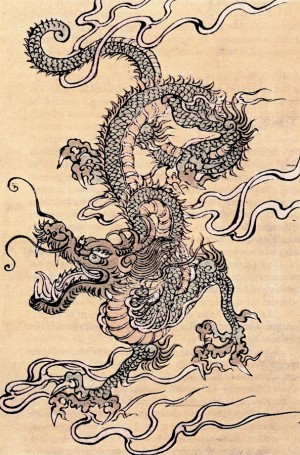
Year 2012 will be a busy and exciting year for particle physics, especially for the International Linear Collider, under the sign of the dragon. Image: Bibliothèque des Arts décoratifs, Paris
The year 2012 will be very busy and exciting. The main task for the ILC physics and detector community is to complete Detailed Baseline Design (DBD) report summarising our effort since 2007. It will consist of two volumes: the physics volume and the detector and simulation volume. The recent news from CERN’s Large Hadron Collider (LHC) is extremely interesting. The clarification of the long-standing question about the Standard Model Higgs particle will create much excitement. The LHC experiments’ smooth progress over the last year suggests that the answer to the Higgs question could be answered by the time we finish the DBD. This development is being followed by the physics group in detail and will be reflected in the physics volume, as was reported by Michael Peskin last November.
For the detector and simulation volume of the DBD, some preparatory steps were made before the change of the year. First, the one-teraelectronvolt beam parameters for benchmark simulation were stamped by the Global Design Effort (GDE). The straw man baseline 2009 (SB2009) working group has kept up discussions with the accelerator experts since LCWS11 in Granada. The new collision scheme, which was introduced and agreed to tentatively in Granada, was replaced with another idea, the shifted-waist technology, which is less challenging technically and produces similar luminosity. We decided to use this latest set of parameters for simulation. By now the software group has finished the first preprocesses with it and is ready for the mass production of simulated events. The two detector groups will be able to start simulations soon.
Second, we formed a subgroup to coordinate the format of the detector and simulation volume of the DBD. Since the two detector groups will write their own detector and simulation sections, it is desirable that they follow a common format. Further, since the DBD will be combined with the GDE’s Technical Design Report for the accelerator, certain coordination with the TDR is also desirable. The subgroup consists of two members from each detector group, T. Behnke and Y. Sugimoto (ILD), P. Burrows and M. Stanitzki (SiD) and the four members from the management, J. Brau, J. Fuster, H. Yamamoto and myself. Phil Burrows is also a member of the TDR editorial group and will serve as a link between TDR and DBD format consideration.
This subgroup met last year to discuss basic questions of the format. They agreed on many key points, particularly those that are needed to be fixed rather soon so that the detector groups can start shaping their sections.
- The detector and simulation volume of the DBD will have three sections, an introductory section and two group sections. The introduction will cover topics common to both detectors and will be about 50 pages long. Each detector part can concentrate on its own specific items and will be up to 150 pages long for the main text.
- First-round ideas on the content and on topic selections for the introduction were exchanged. The subgroup worked also as an editor group and will continue to work that way.
- The content of the detector and simulation sections can be designed by each group. It is natural that they will cover relevant topics included in the Letter of Intent documents. There are differences in their concepts and where emphases are placed may differ accordingly. Such contrast will be welcome since it enhances the strength of the physics capability of the project as a whole. The outline of each section will be submitted to the International Detector Advisory Group (IDAG) in March to be checked during the next IDAG meeting in April.
I wish the details of the subgroup discussions to be shared in each detector group. Although each group has the freedom to organise its part, it is desirable that each section takes a coherent format for a better understanding and comparison for the readers. We learned a lesson through editing the interim report: it is time-consuming to achieve coherence later. Our plan is to make the minutes of the subgroup meetings accessible in our webpages, too. In the meantime there will be further coordination with the TDR editorial board, and tools for drafting, like templates, will also be fixed soon. We will do our best to arrange all the necessary frameworks for the detector groups as soon as possible so that they can start drafting the DBD sections.


Recent Comments